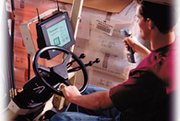Warehouse Management Gets Up to Speed
Warehouse management has become a tricky subject for apparel companies.
With fashion turning faster than ever, replenishment and inventory control have become more important factors within the supply chain. Even the slightest hiccup can have an impact on companies’ bottom lines, and as a result, companies are evaluating their warehousing strategies and are taking a look at how technology can help.
A number of big brands and retailers are consolidating their warehousing operations into super distribution centers. Other companies are bypassing the DC channel altogether and shipping directly to the retailer, while others are opting for third-party providers.
Regardless of who is running the warehouse, automation has become almost mandatory in the marketplace.
Retailers and manufacturers have turned to IT providers for help. The new formula for streamlined warehouse operations encompasses radio frequency (RF) technology and integration into ERP (Enterprise Resource Planning) software, which allows the end parties to track shipments all the way to the sales floor.
Computers can now send advance shipping notices from the factory to the distribution center to alert the receiving department of a shipment’s arrival. Some systems—like Miami-based New Generation Computing’s DCCS (Distribution Center Control System), developed by Six Mile, S.C.–based Foxfire Technologies—can label shipments at the factory level to save time and avoid bottlenecks created by having to label packages at the DC level.
Many systems are using radio-wave technology via handheld scanners and remote terminals to sort packages that require advance shipping notices as required by retail clients who use EDI (Electronic Data Interchange).
Foxfire has taken the process a step further by employing the scanners as task managers, assigning various tasks to personnel through the handheld units as well as ones mounted to forklifts and other shop vehicles.
“We can assign a task to any particular person. We put it in a flow bin and it can tell one person to bring this shipment to aisle 15 or wherever. It can handle hundreds of tasks. In a sense, we are de-skilling the job,” said Jack Peck, chairman of Foxfire. Peck added that the system delegates such tasks in a number of languages. Tasks are categorized by job skills such as “put away,” “replenishment,” “picking,” etc. and are assigned to employees by the system in accordance with defined management priorities. Once assigned, tasks are monitored by the system until they are completed.
Although radio frequency technology has become a standard in the warehouse, companies like Chicago-based SSA Global are also using voice-directed distribution, which uses speech recognition technology delivered through an interface that converts spoken responses to data and vice versa. Workers wear headphones to receive their directions.
“RF can be cumbersome because you have to scan and pick and then check it every time,” said Wilson Rothschild, solutions marketing manager for SSA. Rothschild said the voice-directed system saves time and improves order-picking accuracy and warehouse productivity. The company also has a slotting and optimization module that helps warehouse managers place goods according to user-definable criteria.
“It’s useful for apparel companies because it allows for personalization,” said Rothschild. “If you’re launching a new line of suits, for example, you would want to place them near the dock doors. It helps rotate the inventory, kind of like moving your summer clothes to the front of the drawers as the season approaches.”
DCCS also monitors and enforces task completion, assuring maximum inventory control and accuracy, near 100 percent, said Peck.
Other features include directed put away of reserve stock, floor-ready merchandise preparation, material handling functions, cycle counting, wave management, conveyor PLC interfacing, auto in-line scanning and weighing, audit trails of all activity, suspense triggers, inventory tracking and control, team/individual efficiency assessment, RFpicking, verified case packing and directed loading and shipping.
Peck said DCCS has helped companies increase productivity two- and threefold. And that translates into speed to market, added Matt Brosious, of New Generation Computing.
“Retailers are waiting to see how things sell through at the store level and are reordering based on need. That creates big challenges [for manufacturers],” he said. In addition, retailers are demanding more from their suppliers.
“They want floor-ready merchandise and prepping,” Peck said. “When they get it, they want to put it right on the rack—hangers and stickers all in place.”
Brosious said that more of New Generation’s clients are consolidating their warehousing operations and are building super centers in one region rather than having several in different places. Others are building them at the source, whether it’s China, Mexico or Central America. Manufacturers don’t want to keep stockpiles of inventory in a warehouse in California’s Inland Empire when it’s more cost-effective to store it next to a factory in Central America, added Peck.
“Now, there’s not much time difference between sending something between Atlanta and Los Angeles and San Salvador and Los Angeles,” said Peck.
Still, there’s a need for warehouse space on domestic ground. More companies are consolidating their warehousing into regional super centers. VF Corp.’s VF Outdoor division, for example, has leased an 800,000-square-foot center in Visalia, Calif., that it will move into next year. The center will be the main hub for shipping-and-receiving activity in the West for its large stable of brands.
Third-party provider UPS this month opened a 765,000-square-foot distribution center in Mira Loma, Calif., and has begun construction on a second facility nearby, which is expected to open next year.
The facilities will accommodate the growth from larger consolidated shipments that originate in Asia.
California has become a main hub for state-of-the-art distribution centers because of access to airports and the ports of Long Beach and Los Angeles and is leading the way in adopting new technologies.






















